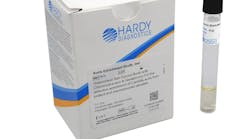The Clinical Laboratory Improvement Advisory Committee (CLIAC) met Sept. 17-18, 2003. This meeting marked the first for new chair, Dr. David Sundwall, and 11 of the 19 committee members. A familiar name to the laboratory industry, Dr. Sundwall is the senior medical and scientific officer of the American Clinical Laboratory Association. The list of members can be viewed at the CLIAC website:
www.phppo.cdc.gov/cliac/roster2003.asp.
CMS update
Judy Yost, director, Division Laboratory Services, Centers for Medicare and Medicaid Services (CMS) gave a CLIA update. The total number of CLIA-certified laboratories remains steady around 180,000 entities, with about 101,000 being physician office laboratories
(POL).
CMS has been busy training all of its inspectors on the Jan. 23, 2003, Federal Register publication of the final CLIA Quality Control (QC) System Regulations. Still on track for publication this fall are the Surveyor Guidelines, which will be placed on CLIAs website (www.cms.gov/clia), and a POL brochure. The POL brochure is designed to teach POL directors and staff about the latest CLIA nonwaived QC requirements.
Ms. Yost reiterated CMS stance that the first round of inspections with the new QC requirements will be educational and not punitive. The only time a deficiency will be cited, based on the new requirements, will be if there is evidence of risk to patient safety.
One of the next big issues CMS will deal with is the development and publication of CLIA requirements relevant to genetic tests. CMS will be soliciting comments to address many questions such as: What is the scope of a genetic test, and where does informed consent fit in?
CDC and FDA updates
Both the Centers for Disease Control and Prevention (CDC) and the Food and Drug Administration (FDA) appear to constantly reinvent themselves. Both groups presentations focused on their internal reorganization and efforts to move into the future with a progressive plan. There are new team players in both entities.
CLIA-waived criteria
The main focus of this meeting was to discuss moving forward to establish final criteria for CLIA-waived tests. This issue has been looming over CLIAC, FDA, CMS, CDC and the industry since HCFA (now CMS) published a Notice of Proposed Rulemaking (NPRM) on Sept. 13, 1995, to establish the waiver criteria. A moratorium on the issuance of new waived tests was recommended by CLIAC in February 1993. The CDC accepted the recommendation and declared a moratorium, but it was lifted in December 1994 when CDC established an interim waiver process. At this meeting, CLIAC acknowledged it is unfair to manufacturers of waived methods to procrastinate on finalizing the criteria.
Rhonda Whalen, MS, chief, Laboratory Practice Standards Branch, Division of Laboratory Systems, Public Health Practice Programs, CDC, gave a comprehensive review of the history and current status of the waived criteria.
Manufacturers currently use one of the following options to seek CLIAs waived status:
- cleared by the FDA for home use,
- matches a test listed in the CLIA regulations, or
- meets clarified criteria and/or guidelines from the 1995
NRPM.
There are currently 72 analytes listed as CLIA-waived that explode to a total of 1,410 test systems which include:
- 240 that were automatically waived due to home-use approval,
- 990 tests systems that are waived by regulation (fall into the nine tests waived by statute), and
- 180 that were waived through the review process.
CLIAC has discussed the waiver criteria on many occasions and has made numerous recommendations, none of which have made it into final form. The strongest contender to motivate finalization of the waiver criteria is the group AdvaMed, a membership organization that represents the interests of industry manufacturers. AdvaMed has developed a Proposal for Waiver (PFW) based on input from CLIAC, its members and government agencies.
AdvaMeds PFW defines:
- accuracy,
- precision,
- clear roles for the manufacturers responsibilities,
- clear roles for the laboratory directors responsibilities, and
- labeling needs.
The PWF describes the CLIA waiver process as a step-wise approach as follows:
- Step 1: Determine if the test is simple; if yes, go to step 2;
- Step 2: Determine if the test has an insignificant risk of erroneous results by the end user; if yes, go to step 3;
- Step 3: Determine if the testing is accurate; if yes, go to step 4; and
- Step 4: Determine if the labeling is appropriate.
If all steps are answered yes, then the test should be considered for waiver status.
At this meeting, CLIAC approved a motion to organize a group to make a recommendation to CLIAC for the final waiver criteria. The group will be composed of CLIAC representatives, AdvaMed, agency representatives, stakeholders and other interested parties. l
C. Anne Pontius, MBA,
CMPE, MT(ASCP), and a member of MLOs editorial advisory board, is president of Laboratory Compliance Consultants in Raleigh, NC.
November
2003: Vol. 35, No. 11
© 2003 Nelson Publishing, Inc. All rights reserved.





